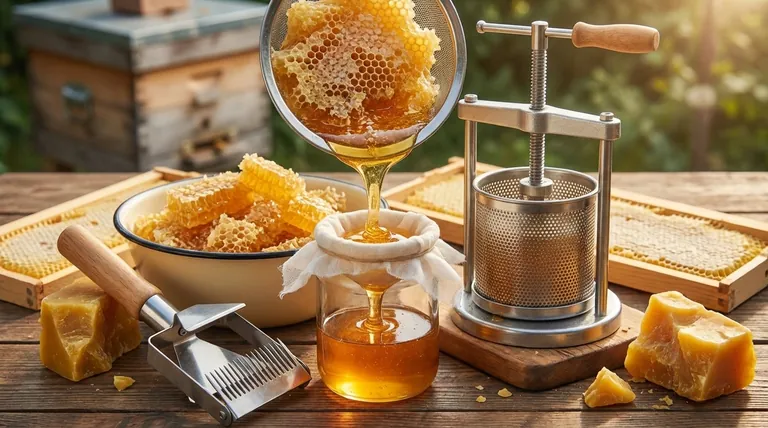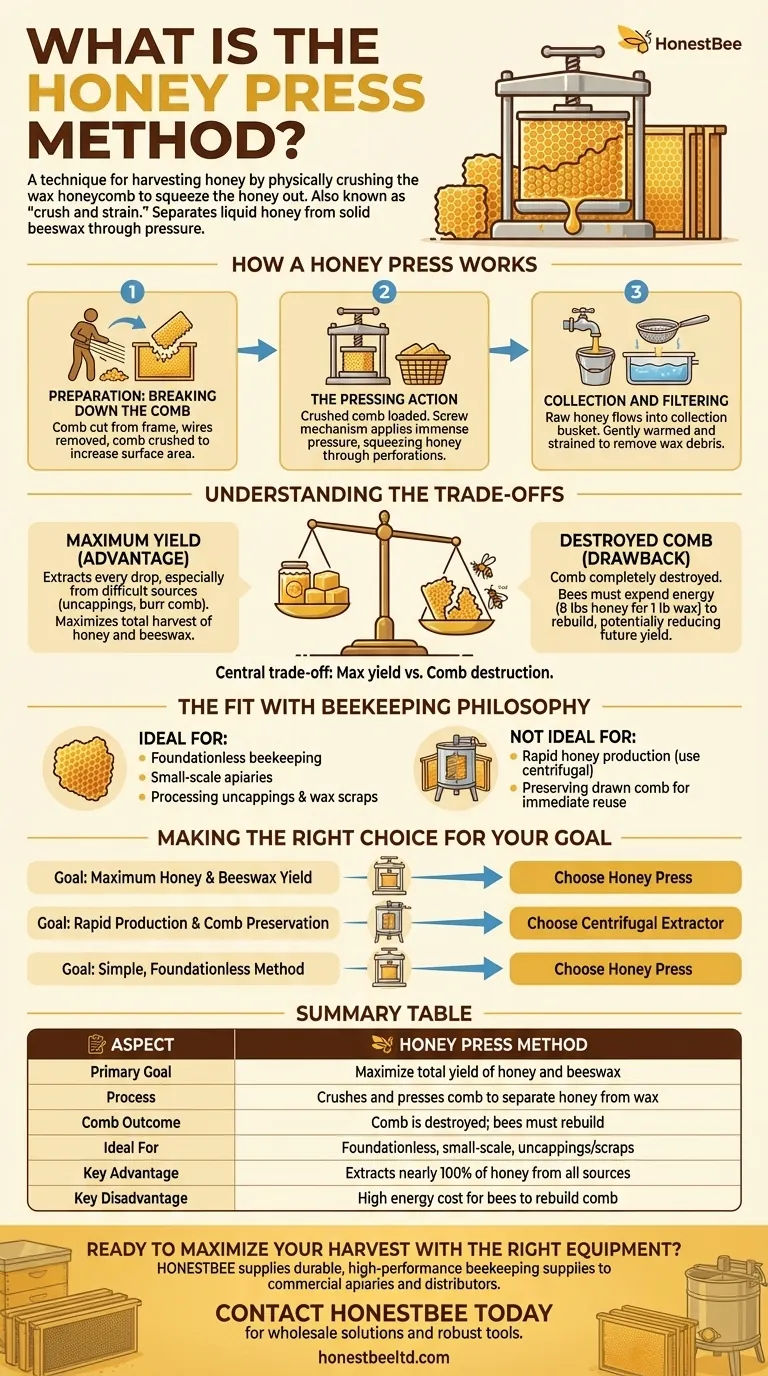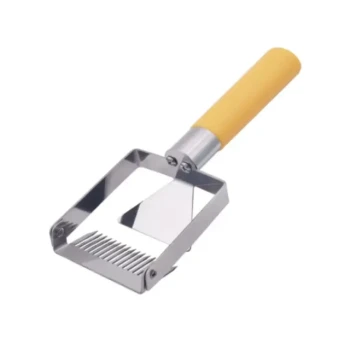At its core, the honey press method is a technique for harvesting honey by physically crushing the wax honeycomb to squeeze the honey out. Also known as the "crush and strain" method, it uses a device called a honey press, or comb crusher, to apply significant pressure, separating the liquid honey from the solid beeswax. This approach stands in contrast to centrifugal extraction, which spins honey out of the comb.
The central decision to use a honey press revolves around a single trade-off: it maximizes the yield of both honey and wax from every piece of comb, but it completely destroys the comb in the process, forcing the bees to rebuild it from scratch.

How a Honey Press Works
The pressing method is a straightforward mechanical process. While designs vary, the core principles of preparation, pressing, and collection are consistent.
Preparation: Breaking Down the Comb
Before pressing, the honeycomb is typically cut from its wooden frame. If the frame contains wires for support, they must be removed.
The comb is then broken up or crushed. This initial step increases the surface area and makes the subsequent pressing action far more efficient.
The Pressing Action
The crushed comb is loaded into the basket of the honey press. The press, which should be bolted to a sturdy surface, uses a screw mechanism to lower a plate onto the comb.
As the operator turns the handle, immense pressure is applied, squeezing the honey through perforations in the basket while retaining the majority of the solid beeswax. This is done slowly and steadily until honey stops flowing.
Collection and Filtering
The raw honey flows from a spout at the base of the press into a collection bucket. This honey is unfiltered and will contain fine particles of wax, pollen, and propolis.
After pressing, the honey is often gently warmed in a water bath to reduce its viscosity. It is then strained through a fine mesh or cheesecloth to remove the remaining wax debris, resulting in a clean product ready for bottling.
Understanding the Trade-offs
Choosing the press method requires a clear understanding of its distinct advantages and significant drawbacks. It is not the right choice for every beekeeper.
The Primary Advantage: Maximum Yield
A honey press excels at extracting every last drop of honey, especially from sources that are difficult to process otherwise. This includes uncappings, burr comb, and other wax scraps that would be wasted in a centrifugal extractor.
This makes it an excellent tool for maximizing the total harvest of both honey and valuable beeswax.
The Primary Drawback: Destroyed Comb
The most significant downside is that the comb is completely destroyed. Bees expend a tremendous amount of energy and resources (consuming about 8 pounds of honey to produce 1 pound of wax) to build their comb.
Destroying the comb means the colony must dedicate its workforce to rebuilding rather than foraging and producing more honey, potentially reducing the following season's yield.
The Fit with Beekeeping Philosophy
This method is particularly well-suited for foundationless beekeeping. In this approach, beekeepers allow bees to build their own comb without pre-made foundation, and the entire comb is often harvested anyway.
For beekeepers on a smaller scale, a press is often more compact, easier to store, and less expensive than a large centrifugal extractor.
Making the Right Choice for Your Goal
Selecting your harvesting method depends entirely on what you want to optimize for.
- If your primary focus is maximum honey and beeswax yield: The press is the superior choice, as it efficiently processes all comb and wax scraps with minimal loss.
- If your primary focus is rapid honey production and supporting your bees: Avoid the press for your main frames and use a centrifugal extractor, which preserves the drawn-out comb for immediate reuse.
- If you are a small-scale or foundationless beekeeper: The honey press offers a simple, effective, and philosophically consistent method for harvesting.
Ultimately, understanding the fundamental relationship between honey yield and comb preservation is the key to selecting the right method for your apiary.
Summary Table:
| Aspect | Honey Press Method |
|---|---|
| Primary Goal | Maximize total yield of honey and beeswax |
| Process | Crushes and presses comb to separate honey from wax |
| Comb Outcome | Comb is destroyed; bees must rebuild |
| Ideal For | Foundationless beekeeping, small-scale apiaries, processing uncappings and wax scraps |
| Key Advantage | Extracts nearly 100% of honey, even from difficult sources |
| Key Disadvantage | High energy cost for bees to rebuild destroyed comb |
Ready to maximize your harvest with the right equipment?
As a beekeeper focused on yield, you understand the importance of efficient tools. HONESTBEE supplies durable, high-performance beekeeping supplies and equipment to commercial apiaries and beekeeping equipment distributors through our wholesale-focused operations.
We can provide you with the robust tools you need to implement the honey press method effectively and boost your productivity.
Contact HONESTBEE today to discuss your apiary's needs and explore our wholesale solutions.
Visual Guide

Related Products
- Stainless Steel Pivoting Honey Uncapping Fork with Plastic Handle
- Professional Honey Uncapping Fork Tool with Customizable Tine Options
- All-Stainless Steel Pivoting Honey Uncapping Fork for Beekeeping
- Professional Honey Uncapping Roller for Efficient Harvesting
- Professional Bent Tine Honey Uncapping Fork with Ergonomic Grip
People Also Ask
- What to use to uncap honey? Choose the Right Tool for Your Apiary
- What is the primary use of an uncapping fork in beekeeping? A Guide to Precision Honey Harvesting
- What should be checked before harvesting honey from a new hive? Ensure Colony Survival First
- What is the best method for uncapping honey? A Guide to Speed vs. Comb Preservation
- Why do you uncap honey? Unlock Your Harvest with Efficient Uncapping



















